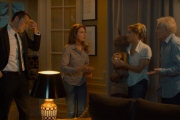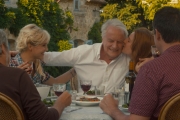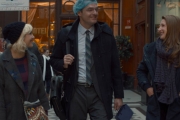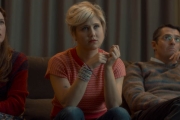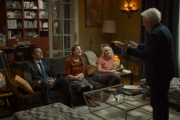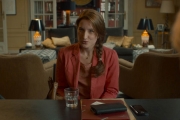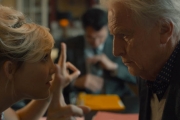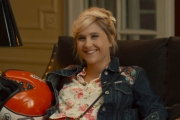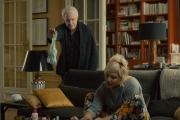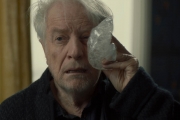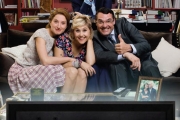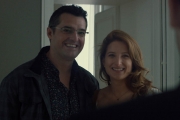![]() Presentation by and discussion with director and screenwriter François Desagnat
Presentation by and discussion with director and screenwriter François Desagnat
Hubert Jacquin, a recent widower, lives by himself in a spacious apartment. Unexpectedly, he finds himself offering a room to a young student, the energetic Manuela. She soon convinces Hubert to accept additional roommates: Marion, a prudish nurse and Paul-Gérard, a young lawyer dumped by his wife. An unlikely family is formed, and the four experience a year filled with surprises, giving Hubert a chance to regain his enthusiasm and purpose in life.
Cast & Crew
Director • François Desagnat
Director of Photography • Vincent Gallot
Screenwriters• François Desagnat, Jérôme Corcos, Catherine Diamant and Stéphane Keller
Music composer • Fabien Cahen
Producers • Jérôme Corcos and Antoine Pezet
Starring :
André Dussollier, Bérengère Krief, Arnaud Ducret and Julia Piaton…
Choose a picture to see the filmography (source : IMDB)
![]()
What did you find interesting in the screenplay of Adopte un veuf?
I was originally given a screenplay about an improbable house-share between an unhappy widower and a young girl student, who wrought havoc in his life. It looked like the story of a man who has never had children and then, all of a sudden, becomes a father. I liked the idea of building up a family life over the course of a year: I like to keep this connecting thread in mind because. I enjoy exploring family relationships, in particular the father-son relationship. This subject is particularly close to my heart. The possibility of having this underlying story was the driving force when it came to directing the film. I directed the actors from the standpoint of a “father” with his “daughter”, “brother” and “sister”.
Even though this is a comedy, the film touches on some serious subjects such as substandard housing and the helplessness of caregivers faced with disease . . .
I like tackling these issues through the medium of comedy. I struggle with films that show the “essentials” and are intent on telling a social story or recounting an injustice. I am more responsive to important subjects that are transmitted through the prism of the characters or by roundabout narration. I am of the opinion that the theme should not take over the film; quite the opposite, it should give it realistic support. Similarly, I wanted to anchor the medical side of the story in reality. However, I felt it would carry more weight to tell the story of an experience that does not go according to plan. Since this film deals with growing up, the character of Marion (played by Julia Piaton) is having a hard time and Hubert (the widower played by André Dussollier) helps her through this episode.
Tell me about the casting process . . .
On one side I had three “young” actors and on the other, I had a great, experienced actor who is generous, gentle and involved. The film is a meeting between generations and this meeting began on the set. It seems obvious to state that Bérengère, Arnaud and Julia were all excited and happy to be working with André, who took great pleasure in working with the young generation. It created a rare emulation, which – I hope – is noticeable on screen. André felt such energy on the part of the “youngsters” that he never wanted to be left out.
Hubert is an individual who has withdrawn but who lets himself be moved . . .
Prior to the death of his wife, he was often out and about, going to see exhibitions and concerts and was a music lover. . . He had a very rich social life. I let this long-buried interest resurface in minor details. So we can see who he was and the person he will become thanks to his co-tenants – the children he never had.
Manuela is an impetuous, intrepid, uncompromising young woman . . .
She is a girl who is looking for herself: she cannot seem to settle down, skipping town with every new year, depending on whether she finds people whom she likes. Her studies are only a pretext and she has nothing to tie her down; she never knew her father and her mother dragged her all over the world on her adventures. Unlike Hubert, she needs time to find a certain balance. Her meeting with Hubert helps her find her way and she understands that she can be at peace with herself while holding onto her singular personality.
The other two co-tenants are more reserved but very generous.
The story revolves around the relationship between Hubert and Manuela: it is essential that the secondary characters do not draw our attention away from them. In fact it is quite the opposite, they add spice to the main storyline. It has to be a pleasure to meet them. One of the hardest things in writing this was therefore delving into the two secondary characters. I wanted to tell the love story between them which meant they had to be both similar and very different. Hubert is very clear-sighted when it comes to people. He is touched by Manuela. With regard to the other two characters, he feels he can trust them and he does not have to hold back.
Tell me how you chose the apartment . . .
We wondered whether to go with a natural decor or not. The choice of apartment is crucial as we must immediately be able to feel we are in an apartment in a large, 19th century Parisian building. I described Hubert’s story to the head decorator to allow her to design his interior. The decor had to be a character in itself because the decor is a manifestation of the ghost of Hubert’s wife. We also had to show how each room in this spacious apartment had been occupied by a childless couple. Thus, Hubert’s wife’s workshop became Marion’s room, Hubert’s office became PG’s room. Just like any other character, the decor evolves throughout the film, from darkness to light, following on from the transformations due to the arrival of the co-tenants.
What choices did you make with regard to directing the film?
This is the second film I have directed myself. I wanted to make strong and accurate directing choices that give the film its identity. By the way, the most significant scenes, which I imagined would emphasise this identity, were left out during editing! (Laughs). Anyway, most of what we filmed is still there.
We shot the whole film using a Stab One system. This apparatus is a combination of shoulder-carried camera and Steadicam; it has a gyro-stabilising system that allowed us to use a hand-held camera all the time without suffering the jumpy aspect of this type of filming. This choice was originally dictated by economics but as always, we tried to turn a necessity into a strength. It meant we often did lengthy shots which allowed us to follow the characters closely and to use every nook and cranny in the apartment.
What music did you want for the film?
It is the first time I have worked with Fabien Cahen. I had a very specific idea of what I wanted: the soundtracks by Rob Simonsen, a young American composer who worked on The Spectacular Show and Cet été-là (The Way Way Back). I remember saying to myself, “that is the colour of the music for my film”, something very minimalist with a hint of folk music and mixture of guitar and piano. I talked it over with the people in charge of the musical supervision. I was sent 7 or 8 demos by composers – some I knew, others I did not – and then I discovered Fabien’s music. There were two numbers that were exactly what I was looking for. We met each other and found out that we were the same age and had a lot in common. I very quickly became quite excited about going ahead with him.
Press Kit “Adopte un veuf”
French ~ 20 pages ~ 794 Ko ~ pdf



